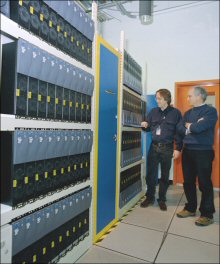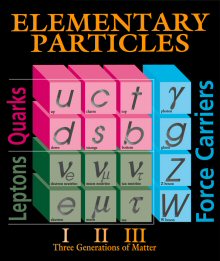Inquiring Minds
|
Physics at Fermilab main page | accelerators | collider experiments | neutrino physics | technology computing | theory | astrophysics | discoveries at Fermilab |
||||
|
||||
|
Roughly half of our understanding of the physical world comes from direct experiment, while the other half comes from the systematic, logical fomulation of the laws of nature known as theoretical physics. Our modern machines, from the radio and microwave oven to supercomputers and the Tevatron, rely upon the established theories of nature--the laws of electrodynamics, quantum physics and relativity--and their profound and arcane mathematics.
Some Fermilab theorists are experts in the calculation of the various phenomena that arise from the fundamental interactions of quarks and gluons. Quantum Chromodynamics, one of the triumphs of 20th century physics, is a theory which correctly describes the strong interactions of quarks. Calculating the precise consequences of QCD in high-energy collisions is an extraordinarily painstaking and difficult undertaking. It commands the use of a wide range of advanced mathematical methods and the development of sophisticated and detailed computer simulations. Perturbative QCD is a systematic method used by theorists to analyze the high-energy interactions of quarks and gluons. The quark and gluon sub-structure of protons and antiprotons, and the pattern of events that result when protons and antiprotons collide, can be calculated using perturbative QCD. A remarkable phenomenon of QCD is the "quark jet," where a blast of particles moving together in one common direction emerges from a high-energy collision. The jet allows physicists to track the motion of a single quark in an energetic collision. The behavior of jets, and the production of heavy quarks such as top and bottom, is the mainstay of perturbative QCD applications at Fermilab. These dauntingly complex calculations allow physicists to distinguish potentially new phenomena, like supersymmetry or new strong forces, from the complicated manifestations of the known interactions of quarks and gluons in the Tevatron data.
Fermilab theorists also study quark and lepton flavor physics. The six different types, or flavors, of quarks and leptons are grouped into three generations. Physicists study the decays of quarks to understand what causes the observed pattern of quark masses and transitions between different quark flavors. For example, studying the precise ways that bottom and strange quarks decay may reveal new physics associated with new phenomena, such as supersymmetry, that haven't yet been experimentally observed. Bottom and strange quark decays also provide insight into CP violation, the mysterious force that may ultimately reveal the reason why the universe is made up of matter instead of antimatter. Members of the Theory Department are active in many aspects of neutrino physics, such as the implication of neutrino mass, and how neutrinos may be used to study astrophysical phenomena. The future program of neutrino physics at Fermilab is likely to be shaped as much by theory as by new experimental discoveries. Most scientists believe that our Standard Model of the quarks and leptons and their interactions is incomplete. Fermilab theorists are world leaders in helping to create, shape and define theories of new physics such as supersymmetry, possible new strong forces and extra space-time dimensions that may lie beyond the present Standard Model. They study means to test different aspects of these ideas and identify particular processes that are best suited to observe hypothetical new phenomena in collider experiments. |
| last modified 8/31/2004 email Fermilab |
FRLsDFx9eyfrPXgV




